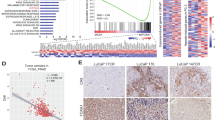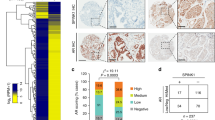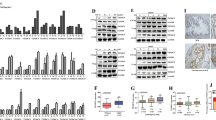Abstract
Androgen receptor (AR) signaling is involved in the development and progression of prostate cancer. Tumor microvasculature contributes to continual exposure of prostate cancer cells to hypoxia–reoxygenation, however, the role of hypoxia–reoxygenation in prostate cancer progression and modulation of AR signaling is not understood. In this study, we evaluated the effects of hypoxia–reoxygenation in LNCaP cells, a line of hormone responsive human prostate cancer cells. Our results demonstrate that hypoxia–reoxygenation resulted in increased survival, higher clonogenicity and enhanced invasiveness of these cells. Moreover, hypoxia–reoxygenation was associated with an increased AR activity independent of androgens as well as increased hypoxia inducible factor (HIF-1α) levels and activity. We also observed that the activation of p38 mitogen-activated protein (MAP) kinase pathway was an early response to hypoxia, and inhibition of p38 MAP kinase pathway by variety of approaches abolished hypoxia–reoxygenation induced increased AR activity as well as increased survival, clonogenicity and invasiveness. These results demonstrate a critical role for hypoxia-induced p38 MAP kinase pathway in androgen-independent AR activation in prostate cancer cells, and suggest that hypoxia–reoxygenation may select for aggressive androgen-independent prostate cancer phenotype.
This is a preview of subscription content, access via your institution
Access options
Subscribe to this journal
Receive 50 print issues and online access
$259.00 per year
only $5.18 per issue
Buy this article
- Purchase on Springer Link
- Instant access to full article PDF
Prices may be subject to local taxes which are calculated during checkout






Similar content being viewed by others
Change history
19 May 2022
This article has been retracted. Please see the Retraction Notice for more detail: https://doi.org/10.1038/s41388-022-02357-z
References
Akakura N, Kobayashi M, Horiuchi I, Suzuki A, Wang J, Chen J et al. (2001). Constitutive expression of hypoxia-inducible factor-1alpha renders pancreatic cancer cells resistant to apoptosis induced by hypoxia and nutrient deprivation. Cancer Res61: 6548–6554.
Asirvatham AJ, Schmidt M, Gao B, Chaudhary J . (2006). Androgens regulate the immune/inflammatory response and cell survival pathways in rat ventral prostate epithelial cells. Endocrinology147: 257–271.
Baek SH, Lee UY, Park EM, Han MY, Lee YS, Park YM . (2001). Role of protein kinase C delta in transmitting hypoxia signal to HSF and HIF-1. J Cell Physiol188: 223–235.
Berra E, Pagès G, Pouysségur J . (2000). MAP kinases and hypoxia in the control of VEGF expression. Cancer Metastasis Rev19: 139–145.
Bhattacharya S, Michels CL, Leung MK, Arany ZP, Kung AL, Livingston DM . (1999). Functional role of p35srj, a novel p300/CBP binding protein, during transactivation by HIF-1. Genes Dev13: 64–75.
Boddy JL, Fox SB, Han C, Campo L, Turley H, Kanga S et al. (2005). The androgen receptor is significantly associated with vascular endothelial growth factor and hypoxia sensing via hypoxia-inducible factors HIF-1a, HIF-2a, and the prolyl hydroxylases in human prostate cancer. Clin Cancer Res11: 7658–7663.
Butterworth KT, McCarthy HO, Devlin A, Ming L, Robson T, McKeown SR et al. (2008). Hypoxia selects for androgen independent LNCaP cells with a more malignant geno- and phenotype. Int J Cancer123: 760–768.
Calvani M, Trisciuoglio D, Bergamaschi C, Shoemaker RH, Melillo G . (2008). Differential involvement of vascular endothelial growth factor in the survival of hypoxic colon cancer cells. Cancer Res68: 285–291.
Carmeliet P, Jain RK . (2000). Angiogenesis in cancer and other diseases. Nature407: 249–257.
Cheng WS, Giandomenico V, Pastan I, Essand M . (2003). Characterization of the androgen-regulated prostate-specific T cell receptor gamma-chain alternate reading frame protein (TARP) promoter. Endocrinology144: 3433–3440.
Culig Z, Bartsch G . (2006). Androgen axis in prostate cancer. J Cell Biochem99: 373–381.
Horii K, Suzuki Y, Kondo Y, Akimoto M, Nishimura T, Yamabe Y et al. (2007). Androgen-dependent gene expression of prostate-specific antigen is enhanced synergistically by hypoxia in human prostate cancer cells. Mol Cancer Res5: 383–391.
Horoszewicz JS, Leong SS, Kawinski E, Karr JP, Rosenthal H, Chu TM et al. (1983). LNCaP model of human prostatic carcinoma. Cancer Res43: 1809–1818.
Huggins C, Hodges CV . (1941). Studies on prostatic cancer. I. The effect of castration, of estrogen and of androgen injection on serum phosphatases in metastatic carcinoma of the prostate. Cancer Res1: 293–297.
Kimbro KS, Simons JW . (2006). Hypoxia-inducible factor-1 in human breast and prostate cancer. Endocr Relat Cancer13: 739–749.
Kokontis JM, Hay N, Liao S . (1998). Progression of LNCaP prostate tumor cells during androgen deprivation: hormone-independent growth, repression of proliferation by androgen, and role for p27Kip1 in androgen-induced cell cycle arrest. Mol Endocrinol12: 941–953.
Kumar B, Koul S, Khandrika L, Meacham RB, Koul HK . (2008). Oxidative stress is inherent in prostate cancer cells and is required for aggressive phenotype. Cancer Res68: 1777–1785.
Kwon SJ, Song JJ, Lee YJ . (2005). Signal pathway of hypoxia-inducible factor-1alpha phosphorylation and its interaction with von Hippel-Lindau tumor suppressor protein during ischemia in MiaPaCa-2 pancreatic cancer cells. Clin Cancer Res11: 7607–7613.
Luo Y, He DL, Ning L, Shen SL, Li L, Li X et al. (2006). Over-expression of hypoxia-inducible factor-1alpha increases the invasive potency of LNCaP cells in vitro. BJU Int98: 1315–1319.
Maroni PD, Koul S, Chandhoke PS, Meacham RB, Koul HK . (2005). Oxalate toxicity in cultured mouse inner medullary collecting duct cells. J Urol174: 757–760.
McDonald DM, Choyke PL . (2003). Imaging of angiogenesis: from microscope to clinic. Nat Med9: 713–725.
Milosevic M, Chung P, Parker C, Bristow R, Toi A, Panzarella T et al. (2007). Androgen withdrawal in patients reduces prostate cancer hypoxia: implications for disease progression and radiation response. Cancer Res67: 6022–6025.
Miyazaki Y, Hara A, Kato K, Oyama T, Yamada Y, Mori H et al. (2008). The effect of hypoxic microenvironment on matrix metalloproteinase expression in xenografts of human oral squamous cell carcinoma. Int J Oncol32: 145–151.
Mortimer HJ, Peacock AJ, Kirk A, Welsh DJ . (2007). p38 MAP kinase: essential role in hypoxia-mediated human pulmonary artery fibroblast proliferation. Pulm Pharmacol Ther20: 718–725.
Murata M, Yudoh K, Nakamura H, Kato T, Inoue K, Chiba J et al. (2006). Distinct signaling pathways are involved in hypoxia- and IL-1-induced VEGF expression in human articular chondrocytes. J Orthop Res24: 1544–1554.
Pagès G, Berra E, Milanini J, Levy AP, Pouysségur J . (2000). Stress-activated protein kinases (JNK and p38/HOG) are essential for vascular endothelial growth factor mRNA stability. J Biol Chem275: 26484–26491.
Park SY, Kim YJ, Gao AC, Mohler JL, Onate SA, Hidalgo AA et al. (2006). Hypoxia increases androgen receptor activity in prostate cancer cells. Cancer Res66: 5121–5129.
Pouysségur J, Dayan F, Mazure NM . (2006). Hypoxia signalling in cancer and approaches to enforce tumour regression. Nature441: 437–443.
Powell CS, Wright MM, Jackson RM . (2004). p38mapk and MEK1/2 inhibition contribute to cellular oxidant injury after hypoxia. Am J Physiol Lung Cell Mol Physiol286: L826–L833.
Repesh LA . (1989). A new in vitro assay for quantitating tumor cell invasion. Invasion Metastasis9: 192–208.
Rizzino A . (1987). Soft agar growth assays for transforming growth factors and mitogenic peptides. Methods Enzymol146: 341–352.
Shida Y, Igawa T, Hakariya T, Sakai H, Kanetake H . (2007). p38MAPK activation is involved in androgen-independent proliferation of human prostate cancer cells by regulating IL-6 secretion. Biochem Biophys Res Commun353: 744–749.
Sumbayev VV, Yasinska IM . (2005). Regulation of MAP kinase-dependent apoptotic pathway: implication of reactive oxygen and nitrogen species. Arch Biochem Biophys436: 406–412.
Sung SY, Kubo H, Shigemura K, Arnold RS, Logani S, Wang R et al. (2006). Oxidative stress induces ADAM9 protein expression in human prostate cancer cells. Cancer Res66: 9519–9526.
Vleugel MM, Greijer AE, Shvarts A, van der Groep P, van Berkel M, Aarbodem Y et al. (2005). Differential prognostic impact of hypoxia induced and diffuse HIF-1alpha expression in invasive breast cancer. J Clin Pathol58: 172–177.
Winzen R, Kracht M, Ritter B, Wilhelm A, Chen CY, Shyu AB et al. (1999). The p38 MAP kinase pathway signals for cytokine-induced mRNA stabilization via MAP kinase-activated protein kinase 2 and an AU-rich region-targeted mechanism. EMBO J18: 4969–4980.
Xu L, Chen S, Bergan RC . (2006). MAPKAPK2 and HSP27 are downstream effectors of p38 MAP kinase-mediated matrix metalloproteinase type 2 activation and cell invasion in human prostate cancer. Oncogene25: 2987–2998.
Yoshino Y, Aoyagi M, Tamaki M, Duan L, Morimoto T, Ohno K . (2006). Activation of p38 MAPK and/or JNK contributes to increased levels of VEGF secretion in human malignant glioma cells. Int J Oncol29: 981–987.
Zetter BR . (1998). Angiogenesis and tumor metastasis. Annu Rev Med49: 407–424.
Zhong H, Agani F, Baccala AA, Laughner E, Rioseco-Camacho N, Isaacs WB et al. (1998). Increased expression of hypoxia inducible factor-1alpha in rat and human prostate cancer. Cancer Res58: 5280–5284.
Zhong H, Chiles K, Feldser D, Laughner E, Hanrahan C, Georgescu MM et al. (2000). Modulation of hypoxia-inducible factor 1alpha expression by the epidermal growth factor/phosphatidylinositol 3-kinase/PTEN/AKT/FRAP pathway in human prostate cancer cells: implications for tumor angiogenesis and therapeutics. Cancer Res60: 1541–1545.
Zoubeidi A, Zardan A, Beraldi E, Fazli L, Sowery R, Rennie P et al. (2007). Cooperative interactions between androgen receptor (AR) and heat-shock protein 27 facilitate AR transcriptional activity. Cancer Res67: 10455–10465.
Acknowledgements
Supported in part by NIH/NCI-P20 CA103680-Schwartz/Byers Program PI's (H Koul, Pilot-Project PI), Student Cancer Research Fellowship Program (H Koul, Preceptor), University of Colorado Cancer Center and Department of Surgery—School of Medicine Academic Enrichment Funds (H Koul). We thankfully acknowledge service provided by University of Colorado Cancer Center Flow Cytometry Core. We thank Dr Andrew Kung (Dana-Faber Cancer Institute, Boston, MA, USA) for 3 × HRE luciferase plasmid, Dr Magnus Essand (Uppsala University, Sweden) for AR responsive Luciferase Vector PSAe/TARPp and Professor Matthias Gaestel (Institute of Biochemistry, Medical School, Hannover, Germany) for MK2 expression plasmids.
Author information
Authors and Affiliations
Corresponding author
About this article
Cite this article
Khandrika, L., Lieberman, R., Koul, S. et al. RETRACTED ARTICLE: Hypoxia-associated p38 mitogen-activated protein kinase-mediated androgen receptor activation and increased HIF-1α levels contribute to emergence of an aggressive phenotype in prostate cancer. Oncogene 28, 1248–1260 (2009). https://doi.org/10.1038/onc.2008.476
Received:
Revised:
Accepted:
Published:
Issue Date:
DOI: https://doi.org/10.1038/onc.2008.476
Keywords
This article is cited by
-
Low dose radiation upregulates Ras/p38 and NADPH oxidase in mouse colon two months after exposure
Molecular Biology Reports (2023)
-
The role of hypoxia on prostate cancer progression and metastasis
Molecular Biology Reports (2023)
-
Glucocorticoid receptors are required effectors of TGFβ1-induced p38 MAPK signaling to advanced cancer phenotypes in triple-negative breast cancer
Breast Cancer Research (2020)
-
Inhibiting MAPK14 showed anti-prolactinoma effect
BMC Endocrine Disorders (2020)
-
Marine alkaloid monanchoxymycalin C: a new specific activator of JNK1/2 kinase with anticancer properties
Scientific Reports (2020)



